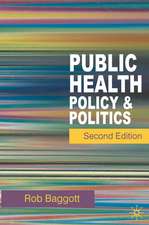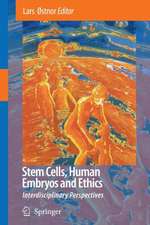Bacterial Plasmids and Antibiotic Resistance: First International Symposium Infectious Antibiotic Resistance. Castle of Smolenice, Czechoslovakia 1971
Editat de V. Krcmery, L. Rosival, T. Watanabeen Limba Engleză Paperback – 19 iun 2012
Preț: 381.54 lei
Preț vechi: 401.61 lei
-5% Nou
Puncte Express: 572
Preț estimativ în valută:
73.02€ • 75.43$ • 60.77£
73.02€ • 75.43$ • 60.77£
Carte tipărită la comandă
Livrare economică 26 martie-09 aprilie
Preluare comenzi: 021 569.72.76
Specificații
ISBN-13: 9783642492693
ISBN-10: 364249269X
Pagini: 464
Ilustrații: 452 p. 65 illus., 10 illus. in color.
Dimensiuni: 170 x 244 x 24 mm
Greutate: 0.74 kg
Ediția:Softcover reprint of the original 1st ed. 1972
Editura: Springer Berlin, Heidelberg
Colecția Springer
Locul publicării:Berlin, Heidelberg, Germany
ISBN-10: 364249269X
Pagini: 464
Ilustrații: 452 p. 65 illus., 10 illus. in color.
Dimensiuni: 170 x 244 x 24 mm
Greutate: 0.74 kg
Ediția:Softcover reprint of the original 1st ed. 1972
Editura: Springer Berlin, Heidelberg
Colecția Springer
Locul publicării:Berlin, Heidelberg, Germany
Public țintă
ResearchDescriere
Antibiotics are one of the greatest benefits science ever gave to mankind and one of the few things that cannot be misused against the man. Thus, the starting point of all our efforts is highly humanistic, and is expressed by cordial athmosphere in which we all work and communicate on a wide international basis. All our efforts are aimed to preserve the antibiotics as effective tools in medical treat ment, and thus we must deal with antibiotic resistance. Owing to it many antibiotics are slowly retreating from the first line of the battle between the man and pathogens. But new drugs are coming and we must check them very carefully to assure their efficiency as long as possible. In this process of inactivation of antibiotics, infectious resistance factors are today on the scene not only of clinicians, epidemiologists or hygienists, but equally, if not more, of geneticists and molecular-biologists. This is why we all were together in Smolenice to exchange our ideas and experience.
Cuprins
OPENING LECTURES Further outlooks of antibiotics in the shadows of resistance factors.- Problems of transferable antibiotic resistance in Czechoslovakia.- I. Public-Health and Clinical Aspects of Resistance and of R Factors.- In vivo transfer of a plasmid governing Gentamycin resistance.- Properties of an R factor from Pseudomonas aeruginosa.- Some properties of R factors isolated from Pseudomonas aeruginosa.- In vitro and in vivo transfer of the R factor to Yersinia pseudotuberculosis cells.- The occurrence of transferable antibiotic resistance in enteric bacteria isolated in Poland.- Epidemiological investigations of R factors in man and animals in Switzerland.- Multiple drug resistance of pathogens in purulent surgical infections.- Studies on the drug resistance of Staphylococci and Escherichia coli against antibiotics. General tendency of resistant strains and multiple-drug resistances.- Resistance transfer in vivo and its inhibition.- Antibiotics, animals and R factors in man.- Bacterial drug resistance in animals.- Increase of Flavomycin sensitivity of bacteria by R factors.- An improved technique for quantitative detection of fecal coliforms and Pseudomonas aeruginosa on surfaces and in air.- Development of resistance and its suppression under the influence of various Penicillins.- Fish culturing and R factors.- Epidemiological surveillance of drug resistance.- Frequency of colicine production and occurrence of transmissible resistance in haemolytic strains of E. coli, isolated from diarrhetic pigs.- Transmissible resistance in routine laboratory practice.- II. Genetic and Molecular-Biologic Aspects of Resistance Factors.- Antibiotics as tools in cell research.- A genetic analysis of conjugational transfer and its control.- Drug resistance factors: The role of host-specific restriction and modification of DNA.- High-frequency transduction of tetracycline resistance marker of R factor by bacteriophage P22 in Salmonella typhimurium.- Genetics of colicinogenic factors and their recombination with R factors.- The regulation of replication of episomal DNA.- Recombination between different R(f) and R(i) plasmids and between R-plasmids and the chromosome in E. coli and P. mirabilis.- Transfer of streptomycin resistance by the plasmid R 222.- R factors carrying genes governing resistance to ?-lactam drugs, studied in different bacterial hosts.- Betalactamase gene expession in enteric bacteria infected with R factors.- Investigation of the molecular structure of R factors.- Molecular nature of bacterial plasmids.- Elimination of bacterial episomes by DNA-complexing compounds.- Effects of superinfection immunity on plasmid replication following conjugation.- Phenotypic expression of ?-lactamase activity in diferent strains carrying the TEM R-factor.- Studies on the regulation of the chloramphenicol acetyl transferase mediated by R factors.- Enzymatic inactivation of aminoglycoside antibiotics by resistant strains of bacteria.- R factors-determined changes in permeability of E. coli towards rifampicin and other antibiotics.- Gene transfer in the Rhizobium conjugation.- Genetic mapping of regulator gene of phage 16–3 of Rhizobium meliloti.- III. Resistance Determinants in Staphylococcus Aureus.- On the mechanism of Methicillin resistance in Staphylococcus aureus.- Extrachromosomal and chromosomal drug resistance in Methicillin resistant Staphylococcus aureus.- Linkage between determining penicillinase production and behaviour in the presence of crystal violet in staphylococci.- Incidence of antibiotic resistant staphylococci in humans from different environments in Slovakia.- Concomitant loss of markers during elimination of tetracycline markers in Staphylococcus aureus.- IV. Colloquium on Tetracycline Resistance.- On the mechanism of Tetracycline action and resistance: Association of tetracyclines with ribosomes and ribosomal subunits, studied by a fluorometric method.- R factor-determined states of Tetracycline resistance in Shigella flexneri.- The molecular basis of Tetracycline resistance in Staphylococcus aureus.- Nongenetic adaptation of Bacillus cereus 569H to Tetracycline.- Author Index.













